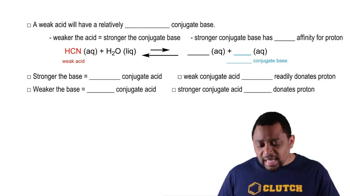Here are the essential concepts you must grasp in order to answer the question correctly.
Buffer Solutions
A buffer solution is a system that resists changes in pH upon the addition of small amounts of acid or base. It typically consists of a weak acid and its conjugate base or a weak base and its conjugate acid. This equilibrium allows the buffer to neutralize added acids or bases, maintaining a relatively stable pH.
Recommended video:
Weak Acids and Conjugate Bases
Weak acids partially dissociate in solution, establishing an equilibrium between the undissociated acid and its ions. The conjugate base is formed when the weak acid donates a proton. In buffer solutions, the presence of both the weak acid and its conjugate base allows for effective pH stabilization.
Recommended video:
Conjugate Acid-Base Relationships
pH and Neutralization Reactions
pH is a measure of the acidity or basicity of a solution, with lower values indicating higher acidity. Neutralization reactions occur when an acid reacts with a base, producing water and a salt. Understanding how these reactions affect pH is crucial for determining whether a mixture will form a buffer solution.
Recommended video:
 Verified step by step guidance
Verified step by step guidance

